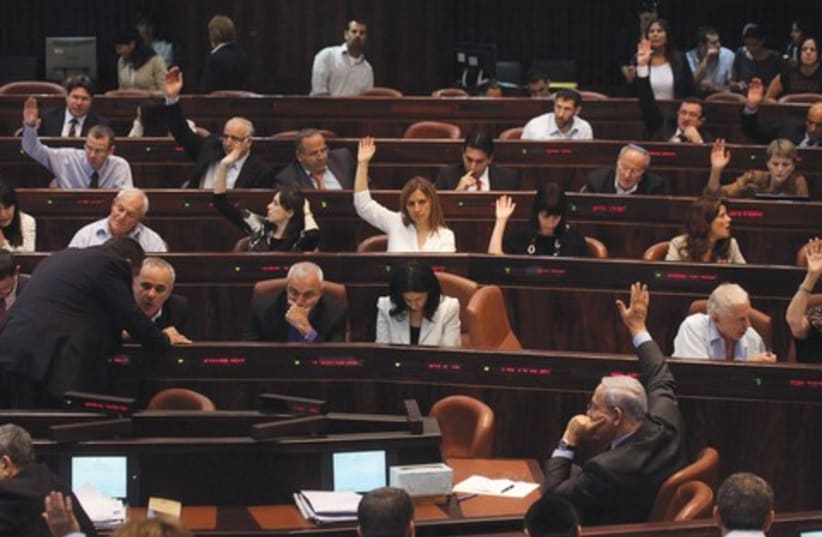I believe that far from endangering Israeli democracy, the current legislative initiatives promoting NGO transparency and a curb on judicial activism is essential for preserving democracy.
The legislation is designed to prevent a situation where only the Left is capable of implementing major policy, while a nationalist government it is stymied by lawfare aided by one-sided judicial activism. What has created the current confusion is the deluge of legislation. Each law on its own is eminently defensible (and if I were offered an op-ed for each piece of legislation, I could write one). However, taken together the plethora of legislation from wellintentioned Knesset members lends superficial credence to the calumny that democracy is under attack.
It would be preferable to concentrate the drive for political reform by removing the judiciary from the judicial selection process. If this goal were to be achieved, many of the other problems prompting the deluge of legislative proposals would be mitigated simultaneously. Israel has a unique judicial selection process in which three sitting members of the High Court are part of the selection panel. They are required by law to act individually, but the rule of law doesn’t bind justices.
The Chief Justice chooses the other two judges and they vote as a bloc. Then we have two members from the Israel Bar Association. These lawyers frequently follow the judges’ cues either out of deference or out of prudence. Tomorrow the lawyers may be presenting a brief before the same judges and they will be hesitant about crossing them. Two Knesset members (one from the coalition and the other from the opposition), the justice minister and another minister round out the panel of nine.
This lineup basically meant that until recently the justices could judicially clone members of the bench since they could count on at least one lawyer and one Knesset member to provide them with a majority. Following an amendment proposed by Education Minister Gideon Sa’ar, a successful candidate would require seven votes. Under the best of circumstances this produces stalemate and the need to make deals – if you vote for my candidate, I’ll vote for yours.
To put it in an American context one would have to imagine a situation whereby Chief Justice John Roberts together with Antonin Scalia and Samuel Alito could have blocked the nomination of Elena Kagan or Sonia Sotomayor and allowed only conservative justices to enter the High Court or conditioned the acceptance of a liberal nominee on the simultaneous acceptance of a conservative justice. This of course cannot happen in the US because only the executive and legislative branches participate in judicial selection. There were activist judges from John Marshal to Thurgood Marshall, but they could not designate their successors.
The Israeli system did not produce difficulties during the 1949-1977 Labor Party “hegemony” in local politics when the court practiced judicial restraint. Only a person who was directly injured could appeal to the court; the court could overturn a government decision on the basis of legality and, as befitting the British system that Israel inherited, the Knesset had the final say. When the court issued a ruling that in the Knesset’s view misinterpreted the will of the legislator it could pass corrective legislation that the judiciary had to implement.
Things changed with the historic Likud victory of 1977. Some justices viewed the court as the guardian of the “enlightened public” (former Chief Justice Aharon Barak’s phrase) and as a super legislator via court rulings. Former Justice Yitzhak Zamir, who shared Barak’s enthusiasm for judicial activism, claims that the court influenced Israel more than the legislative and executive branches. If Zamir is correct then we are dealing with a conscious usurpation of power.
To increase the court’s power to intervene the court substituted the test of plausibility and proportionality (where the court rather than government ministries decides) for the test of legality. This created a situation where nobody knew what the law was. You also did not have to be a specific injured party to appeal, but NGOs could block actions to preclude hypothetical damage to unknown victims.
Judicial intervention on steroids was justified by the justices and their allies portraying the court as a dispassionate purveyor of justice compared with elected politicians, who were at best bumblers and at worst corrupt and debauched. This campaign represented the true threat to democracy and was designed to subordinate elected leaders to the mandarins in the judiciary or civil service. These practices can only be rolled back by assuring balance on the bench.
To demonstrate that no anti-democratic intentions lurk behind its proposed judicial reform the nationalist side should offer a grand bargain. Give us a court that is not predisposed to activism and eroding Israel’s Jewish character and we can proceed with the drafting of a constitution enshrining basic liberties. The weak should be protected by welfare programs passed by the legislature. Social justice is the job of the elected rather than the bench. Nationalists would no longer fear that a constitution would provide judicial activism with a superhighway.
The Left will then have to demonstrate whether it sought constitutionalism as inherently valuable or merely as a tool to perpetuate its power.
